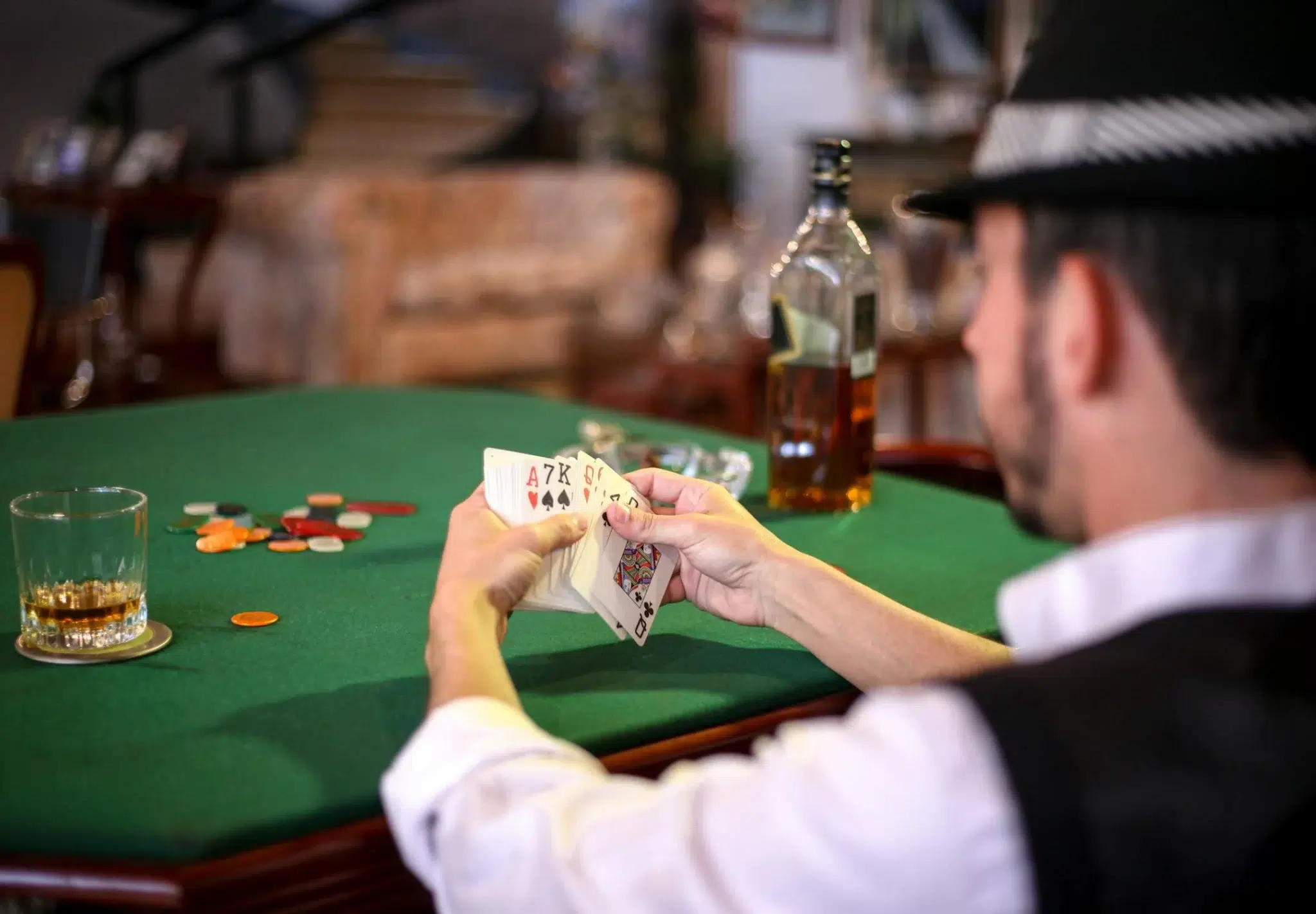Clattering cards, clashing chips, enigmatic looks… The world of poker has undergone a veritable media metamorphosis since the early 2000s. Who hasn’t dreamed of bluffing like Mike McDermott in “The Gamblers” or analyzing their opponents with the precision of Daniel Negreanu? The influence of film and television series on the popularity of poker is undeniable.
This phenomenon has not only democratized this century-old card game, but has also transformed the way amateur and professional players approach their games. From the psychology of bluffing to the mathematics of probability, audiovisual productions have shed light on strategies that were once reserved for a select few.
In this article, we’ll explore how these media portrayals have changed our perception of poker, and more importantly, how you can draw inspiration from these cinematic techniques to improve your own game. Ready to transform your poker experience with lessons from the big and small screen? Sit back, the cards are about to be dealt!
The Golden Age of Poker on Screen: Foundational Works and Cultural Impact
The “Rounders” Effect: The Game-Changing Film
Released in 1998, “Rounders,” starring Matt Damon and Edward Norton, remains the definitive reference in poker films. This feature-length film sparked a revolution in the world of poker by presenting the game not as a simple casino diversion, but as a strategic art requiring intelligence, psychology, and discipline.
The film’s impact on the poker industry was considerable. Chris Moneymaker, winner of the 2003 World Series of Poker (WSOP) Main Event, admitted to being inspired by this film to take up poker. This historic victory by a skilled online amateur coincided with what has become known as the “Poker Boom” of the 2000s.
The film also introduced fundamental strategic concepts such as:
- Reading Tells (Tell-Tell Signs)
- The Importance of Bankroll Management
- The Notion of Statistical Edge
- The Psychology of Bluffing
- Emotional Discipline
TV Series: High Stakes Poker and the Transparency Shift
In the early 2000s, the arrival of shows like “High Stakes Poker” and “Poker After Dark” revolutionized the way the public perceived the game by offering unprecedented transparency. For the first time, viewers could:
- See players’ cards in real time thanks to under-table cameras
- Hear the professionals’ reasoning
- Understand the mathematics behind decisions
- Observe the psychological dynamics between elite players
This democratization of poker knowledge had a massive effect on the overall level of play, transforming once esoteric concepts into widely shared knowledge.
Casino Royale: Poker in Mainstream Culture
The film “Casino Royale” (2006) marked another decisive turning point. By replacing the baccarat of the original novel with Texas Hold’em, this James Bond adaptation exposed poker to an even wider global audience. The final poker scene, with its legendary hand (full house versus full house versus straight flush), although unlikely from a probabilistic point of view, captured the public’s imagination.
Playing Techniques Popularized by Film and Their Real-Life Application
Reading Tells: Hollywood Myth or Reality?
Movies often dramatize players’ ability to “read” their opponents through microexpressions and nervous tics. In “Rounders,” Mike McDermott (Matt Damon) notices that Teddy KGB (John Malkovich) eats Oreos in a certain way when he’s bluffing.
Fact vs. Fiction:
- In movies: Tells are presented as extremely revealing and consistent.
- In real poker: Physical tells exist but are much more subtle and vary from player to player.
Practical application:
To effectively use tells in real-life situations, focus on:
- Repetitive behavioral patterns
- Changes in rhythm or posture
- Timing of decisions (speed vs. hesitation)
- Direction of gaze after looking at the cards
The heroic bluff: when and how to use it
Spectacular bluffing scenes are a staple of on-screen poker. Who hasn’t dreamed of winning a huge pot with a 7-2 offsuit after convincing their opponent they held the ultimate hand?
Optimal Bluffing Technique:
| Type of Bluff | Ideal Context | Recommended Frequency | Associated Risk |
|---|---|---|---|
| Pure Bluff | Tight Tables, Solid Image | 5-10% of Hands | High |
| Semi-Bluff | Strong Draw, Late Position | 15-20% of Draws | Medium |
| Continuation Bet | After Being Preflop Aggressor | 60-70% After Raising | Low |
| Ladder Bluff | Against 1-2 Opponents Maximum | Very Rarely | Very High |
Common Mistake to Avoid: Overbluffing based on movies. In real life, the best players bluff sparingly and in specific situations where the hand structure lends itself to it. Bankroll Management: The Most Important Lesson
Paradoxically, one of the most valuable lessons comes from the failures depicted on screen. In “Rounders,” Worm’s (Edward Norton) descent into hell perfectly illustrates the dangers of poor bankroll management.
Fundamental rules of bankroll management:
Never play with money you can’t afford to lose
- Have at least 20-30 buy-ins for your chosen cash game
- Move down in case of a significant downswing
- Separate poker money from personal finances
- Advanced strategies inspired by film and television pros
Exploit table dynamics like in “Molly’s Game”
The film “Molly’s Game” (2017) offers a unique perspective on the psychology of high-stakes tables. In it, Molly Bloom observes how some players exploit the social dynamics and emotional weaknesses of their opponents. Customizing Approaches:
Adopt a specific counter-strategy for each player profile:
Opponent Profile
Characteristics
| Optimal Counter-Strategy | The Aggressive Player (“Maniac”) | Raises frequently, bluffs often |
|---|---|---|
| Tight play, traps with strong hands | The Conservative Player (“Nit”) | Plays only premium hands |
| Steals his blinds, bluffs his misses | The Calling Station | Calls too often out of curiosity |
| Value betting, minimize bluffs | The Emotional Player | Prone to tilt after bad beats |
| Vary your play to create frustration | The Calculating Pro | Math-based decisions |
| Introduce unpredictability | Game Theory Optimal (GTO) popularized by poker documentaries | Recent documentaries and vlogs by professional players have popularized the GTO (Game Theory Optimal) approach, a mathematically balanced strategy that limits exploitation by opponents. Basics of the GTO approach for beginners: |
Balancing your hand ranges (having an optimal bluff-to-value ratio)
Consistent bet sizing based on pot structure
Defending the blinds with the mathematically correct frequency
- Using blockers and combination theory
- Recommended tool:
- Apps like GTO+ or PioSOLVER allow you to practice GTO strategies, although their full versions are expensive.
- Advanced Reading Techniques Inspired by “The Cincinnati Kid”
Although old, “The Cincinnati Kid” (1965) remains a benchmark for psychological duels. The film brilliantly illustrates how reading goes far beyond simple physical tells. Holistic Reading Technique:
Observe betting patterns across multiple hands
Analyze consistency between actions and revealed hands
Spot deviations from basic style
- Identify specific situations that create discomfort
- How to train like the on-screen pros
- Media-inspired learning platforms
- The explosion of on-screen poker has spawned an entire ecosystem of online training. Sites like MasterClass even offer courses taught by Daniel Negreanu and Phil Ivey, regular stars of televised poker shows. Recommended training resources:
For beginners:
Poker School Online, PokerStrategy
For intermediate players:
Run It Once, Upswing Poker
- For advanced players: Solve For Why Academy, Chip Leader Coaching
- Simulators and analysis tools Training software now allows you to recreate situations seen in movies and TV shows for a clear analysis.
- Essential applications for progress: Equity calculators (Equilab, Flopzilla)
Hand converters to analyze your sessions
Performance trackers (PokerTracker, Hold’em Manager)
Tournament simulators (ICMIZER for finals)
- Integrating range analysis into your daily game
- One of the most powerful concepts popularized by poker broadcasts is range analysis—the art of deducing an opponent’s range of possible hands based on their actions. Practical range analysis exercise:
- Carefully observe the hands your opponents are showing.
- Mentally note the hands they raise/call/fold with.
Gradually build a mental model of their strategy.
Adjust your decisions based on likely ranges rather than trying to guess a specific hand
Common mistakes inspired by Hollywood portrayals
- Overvaluing marginal hands
- In movies, we often see heroes winning with unlikely hands like 7-2 offsuit. In reality, playing these hands is usually a costly mistake in the long run.
- 5 pitfalls to avoid:
- Playing too many weak hands in early position
Calling raises with suited connectors that don’t match the stack
Getting emotionally attached to aces with weak kickers
Chasing draws without the right implied odds
Ignoring table position
- Ignoring bankroll management
- “Lucky You” (2007) shows Huck Cheever (Eric Bana) constantly risking his entire bankroll—a recipe for disaster in real poker.
- Key principle:
- Even the best players in the world experience periods of negative variance. Without rigorous bankroll management, even a technical advantage cannot survive in the long term.
- An obsession with tells at the expense of mathematics
While films focus on psychological aspects, modern poker relies heavily on a solid understanding of mathematics.
Recommended balance for a well-rounded player:
60% mathematics and theory 25% psychology and opponent reading
15% adaptation and creativity
The evolution of poker in the post-media era
Artificial intelligence and the future of poker
- With Libratus’ victory over human pros in 2017, and Pluribus in 2019, AI has revolutionized our understanding of optimal poker. These advances have been widely documented in productions such as the documentary “AlphaGo”.
- AI-driven strategies challenge certain established dogmas:
- Use of variable sizing depending on board textures
More complex balance of bluffing frequencies
Exploiting Your Opponents’ Detailed Tendencies
Online Poker: Recommendations for Beginners
Inspired by the hits seen on television, many players are now starting out with online poker.
- Online Poker Starter’s Guide:
- Start at micro-limits (NL2, NL5)
- Use tracking tools from the beginning
Maintain a bankroll of at least 30 buy-ins
Play at regulated and secure sites
Participate in community forums to improve
- The Return of Live Poker Post-Pandemic
- After a period dominated by online poker, the return to physical tables requires a specific adaptation. Tips for the online-to-live transition:
- Adjust your pace (fewer hands per hour)
- Pay attention to table etiquette
- Develop a neutral poker face
Adapt your strategy to generally weaker opponents
Be prepared for longer sessions
FAQ: Frequently Asked Questions Inspired by Poker Movies and TV Shows
- Are legendary movie hands statistically plausible?
- Question:
- Could the final hand in Casino Royale (full house versus full house versus royal flush) actually occur?
- Answer:
- The probability of such a confrontation is infinitesimal—less than one in millions. Scriptwriters often sacrifice statistical plausibility for the sake of spectacle. In real poker, monster hand confrontations are much rarer.
How can you develop an effective poker face like in the movies?
Question:
Is it really possible to maintain a poker face under all circumstances? Answer: A perfect poker face is difficult to maintain, even for professionals. A more realistic approach is to:
Adopt a consistent routine for all hands Take approximately the same amount of time for each decision
Wear accessories (glasses, cap) to hide your eyes
Training Breathing Control in Stressful Situations Do the card counting methods shown in movies work?
Question: Can you really count cards like in “Las Vegas 21” (21)?
- Answer:
- Card counting works in blackjack, not poker. In Texas Hold’em, analyzing player ranges and tendencies is more important than counting specific cards out (although knowing which cards are out can influence the odds of certain draws).
- How do you manage your emotions when faced with a bad beat like the pros?
- Question:
How do you avoid tilt after suffering a bad beat like the ones you see in televised tournaments? Answer:
Professionals use a variety of techniques: Focus on the long term and the inherent variance of the game
Mindful breathing techniques Stepping back and objectively analyzing the hand
Strategic pauses after difficult emotional plays
Editor’s Opinion Poker portrayals in film and television have undeniably transformed the game, transforming it from a simple casino diversion to a respected mental sport. More than just a passing fad, this influence has enriched poker strategy by popularizing sophisticated concepts to a wide audience.
Although the reality of poker is often less glamorous than its Hollywood counterpart, the strategic lessons we can learn from these works remain valuable. The balance between rigorous mathematics and sophisticated psychology, between disciplined patience and calculated boldness, constitutes the very essence of high-level poker. Whether you’re a casual player looking to impress at your next poker night with friends, or an aspiring professional aiming for the final tables of major tournaments, thoughtfully applying the techniques popularized by the screen can significantly improve your game. Ready to transform your approach to poker?





